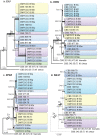Taxonomy and epidemiology of Mucor irregularis, agent of chronic cutaneous mucormycosis
- PMID: 24027346
- PMCID: PMC3734966
- DOI: 10.3767/003158513X665539
Taxonomy and epidemiology of Mucor irregularis, agent of chronic cutaneous mucormycosis
Abstract
Mucormycosis usually presents as a progressive infection with significant angio-invasion. Mucormycosis due to Mucor irregularis (formerly Rhizomucor variabilis var. variabilis), however, is exceptional in causing chronic cutaneous infection in immunocompetent humans, ultimately leading to severe morbidity if left untreated. More than 90 % of the cases known to date were reported from Asia, mainly from China. The nearest neighbour of M. irregularis is the saprobic species M. hiemalis. The aim of this study was to evaluate the taxonomic position, epidemiology, and intra- and inter-species diversity of M. irregularis based on 21 strains (clinical n = 17) by multilocus analysis using ITS, LSU, RPB1 and RPB2 genes, compared to results of cluster analysis with amplified fragment length polymorphism (AFLP) data. By combining MLST and AFLP analyses, M. irregularis was found to be monophyletic with high bootstrap support, and consisted of five subgroups, which were not concordant in all partitions. It was thus confirmed that M. irregularis is a single species at 96.1-100 % ITS similarity and low recombination rates between populations. Some geographic structuring was noted with some localised populations, which may be explained by limited air-dispersal. The natural habitat of the species is likely to be in soil and decomposing plant material.
Keywords: Mucor hiemalis; Mucor irregularis; Mucormycosis; biodiversity; chronic cutaneous infection; epidemiology; taxonomy.
Figures

 = strains from clinical samples;
= strains from clinical samples;  = isolates from soil;
= isolates from soil;  = isolates from plants;
= isolates from plants;  = isolates from animals or animal excretion.
= isolates from animals or animal excretion.


Similar articles
-
Heterothallic mating in Mucor irregularis and first isolate of the species outside of Asia.Med Mycol. 2011 Oct;49(7):714-23. doi: 10.3109/13693786.2011.568975. Epub 2011 Apr 1. Med Mycol. 2011. PMID: 21453223
-
Chronic rhinofacial mucormycosis caused by Mucor irregularis (Rhizomucor variabilis) in India.J Clin Microbiol. 2011 Jun;49(6):2372-5. doi: 10.1128/JCM.02326-10. Epub 2011 Apr 20. J Clin Microbiol. 2011. PMID: 21508154 Free PMC article.
-
Primary cutaneous mucormycosis caused by Mucor irregularis in an elderly person.J Dermatol. 2015 Feb;42(2):210-4. doi: 10.1111/1346-8138.12736. Epub 2014 Dec 16. J Dermatol. 2015. PMID: 25510200
-
Vacuum-Assisted Closure and Skin Grafting Combined with Amphotericin B for Successful Treatment of an Immunocompromised Patient with Cutaneous Mucormycosis Caused by Mucor irregularis: A Case Report and Literature Review.Mycopathologia. 2021 Jun;186(3):449-459. doi: 10.1007/s11046-021-00551-3. Epub 2021 Jun 15. Mycopathologia. 2021. PMID: 34131870 Review.
-
Global Epidemiology of Mucormycosis.J Fungi (Basel). 2019 Mar 21;5(1):26. doi: 10.3390/jof5010026. J Fungi (Basel). 2019. PMID: 30901907 Free PMC article. Review.
Cited by
-
Posttraumatic mucormycosis: a nationwide study in France and review of the literature.Medicine (Baltimore). 2014 Nov;93(24):395-404. doi: 10.1097/MD.0000000000000221. Medicine (Baltimore). 2014. PMID: 25500709 Free PMC article. Review.
-
Role of CARD9 in Cell- and Organ-Specific Immune Responses in Various Infections.Int J Mol Sci. 2024 Feb 23;25(5):2598. doi: 10.3390/ijms25052598. Int J Mol Sci. 2024. PMID: 38473845 Free PMC article. Review.
-
Of Mycelium and Men: Inherent Human Susceptibility to Fungal Diseases.Pathogens. 2023 Mar 14;12(3):456. doi: 10.3390/pathogens12030456. Pathogens. 2023. PMID: 36986378 Free PMC article. Review.
-
A Revised Species Concept for Opportunistic Mucor Species Reveals Species-Specific Antifungal Susceptibility Profiles.Antimicrob Agents Chemother. 2019 Jul 25;63(8):e00653-19. doi: 10.1128/AAC.00653-19. Print 2019 Aug. Antimicrob Agents Chemother. 2019. PMID: 31182532 Free PMC article.
-
Characterization of Two New Records of Mucoralean Species Isolated from Gut of Soldier Fly Larva in Korea.Mycobiology. 2016 Dec;44(4):310-313. doi: 10.5941/MYCO.2016.44.4.310. Epub 2016 Dec 31. Mycobiology. 2016. PMID: 28154489 Free PMC article.
References
-
- Alvarez E, Cano J, Stchigel AM, Sutton DA, Fothergill AW, et al. 2011. Two new species of Mucor from clinical samples. Medical Mycology 49: 62–72 - PubMed
-
- Alvarez E, Stchigel AM, Cano J, Sutton DA, Fothergill AW, et al. 2010b. Molecular phylogenetic diversity of the emerging mucoralean fungus Apophysomyces: proposal of three new species. Revista Iberoamericana de Micología 27: 80–89 - PubMed
LinkOut - more resources
Full Text Sources
Other Literature Sources
Molecular Biology Databases
